
Volleyball is a team sport in which two teams of six players are separated by a net. Each team tries to score points by grounding a ball on the other team's court under organized rules. It has been a part of the official program of the Summer Olympic Games since Tokyo 1964. Beach volleyball was introduced to the programme at the Atlanta 1996 Summer Olympics. The adapted version of volleyball at the Summer Paralympic Games is sitting volleyball.
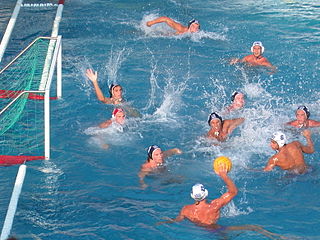
Water polo is a competitive team sport played in water between two teams of seven players each. The game consists of four quarters in which the teams attempt to score goals by throwing the ball into the opposing team's goal. The team with the most goals at the end of the game wins the match. Each team is made up of six field players and one goalkeeper. Excluding the goalkeeper, players participate in both offensive and defensive roles. It is typically played in an all-deep pool where players cannot touch the bottom.

In many team sports that involve scoring goals, the goalkeeper is a designated player charged with directly preventing the opposing team from scoring by blocking or intercepting opposing shots on goal. Such positions exist in bandy, rink bandy, camogie, association football, Gaelic football, international rules football, floorball, handball, hurling, field hockey, ice hockey, roller hockey, lacrosse, ringette, rinkball, water polo, and shinty, as well as in other sports.
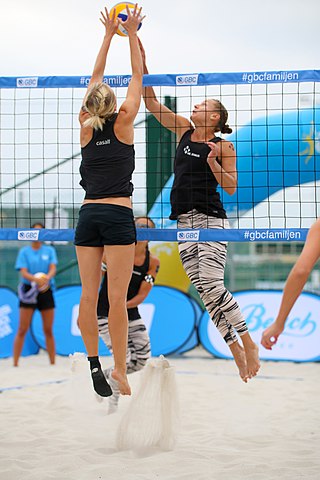
Beach volleyball is a team sport played by two teams of two or more players on a sand court divided by a net. Similar to indoor volleyball, the objective of the game is to send the ball over the net and to ground it on the opponent's side of the court. Each team also works in unison to prevent the opposing team from grounding the ball on their side of the court.
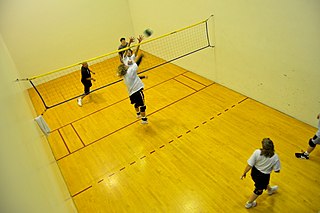
Wallyball is a fast-paced sport that is similar to volleyball played in a racquetball court, where it is legal to hit the ball off of the walls.
This page is a glossary of tennis terminology.
Basketball moves are generally individual actions used by players in basketball to pass by defenders to gain access to the basket or to get a clean pass to a teammate to score.
Hoover ball is a medicine ball game invented by President Herbert Hoover's personal physician, Medal of Honor recipient Joel T. Boone, to help keep then-President Hoover fit. The Hoover Presidential Library Association and the city of West Branch, Iowa co-host a national championship each year.

Fistball is a sport of European origin, primarily played in the German-speaking nations of Austria, Germany and Switzerland, as well as in Brazil. The objective of the game is similar to volleyball, in that teams try to hit a ball over a net, but the rules vary from volleyball in several major ways. The current men's fistball World Champions are Germany, winners of both the 2023 Men's World Championships and the fistball category at the 2022 World Games, while the current women's fistball World Champions are also Germany, after winning the 2021 Women's World Championships.
This is a list of the more common English volleyball jargon terms:
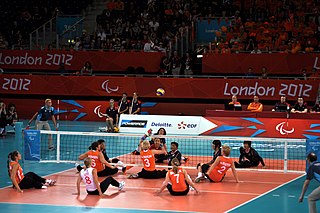
Sitting volleyball is a form of volleyball for athletes with a disability. As opposed to standing volleyball, sitting volleyball players must sit on the floor to play.
Several sports related to volleyball have become popular. Indoor volleyball and beach volleyball are both events at the Olympics, and sitting volleyball is an event at the Paralympics. Other varieties are localised, or are played at an amateur or informal level.
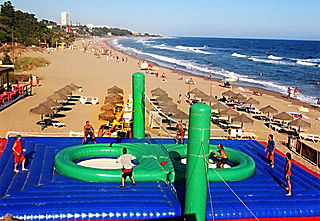
Bossaball is a team sport that originated in Brazil and was conceptualised by Belgian Filip Eyckmans in 2004. Bossaball is a ball game between two teams, combining elements of volleyball, football, and gymnastics with music into a sport. It is played on an inflatable court featuring a trampoline on each side of the net. The trampolines allow the players to bounce high enough to spike the ball over the net.
Volleyball offensive systems are the ways in which a coach can personalize and tweak his or her team's offense based on each player's skill level to make the team as competitive as possible. This is done by using different formations that allow a team to use a variety of volleyball attacks. A team on offense will try to increase the probability of winning a point on a hit by confusing the opposing blockers and disguising the setter's intended receiver as much as possible. This is done keeping in mind that the goal is to score a point and that running a successful offense is executed differently for every team. Teams use offensive systems in whatever way suits the team best.

Roundnet is a ball game created in 1989 by Jeff Knurek, inspired primarily by concepts from volleyball. The game is played between two teams, usually with two players each. Players initially line up around a small trampoline-like net at the start of a point and starts with a serve from one team to another. Teams alternate hitting the ball back to the net.

The history of volleyball in the Philippines refers to the history of volleyball in the Philippines as a recreation and as a sport. Philippine volleyball history began in 1910 when the Philippines was a United States territory (1898–1946). The Filipinos have made significant contributions to volleyball in its evolution as a professional and international game. The Filipinos continued playing volleyball up to the modern-day period in its status as an independent republic (1946–present).

Volleyball is a game played between two opposing sides, with six players on each team, where the players use mainly their hands to hit the ball over a net and try to make the ball land on the opposing team's side of the court. Volleyball is played by over 800 million people world wide, making it one of the most popular sports in the world. Volleyball has some risks involved with it because there are some injuries which occur to players that are quite common; these include ankle injuries, shoulder injuries, foot injuries and knee injuries.
Volleyball drills are specialized exercises that enhance teams and players volleyball skills. There are numerous volleyball drills that teams and players can utilize in order to improve and further develop their skills in all areas of the game such as passing, serving, attacking, setting, blocking, and digging. From beginners to well-seasoned players, drills can help all players gain repetitions in various skills and positions; the more repetitions, the better a player can become.
Snow volleyball is a winter team sport played by two teams of three players on a snow court divided by a net. The objective of each team is to score points by sending a ball over the net so as to ground it on the opponent's court, and to prevent the same effort by the opponent. A team is allowed up to three touches to return the ball across the net, and individual players may not touch the ball twice consecutively.











